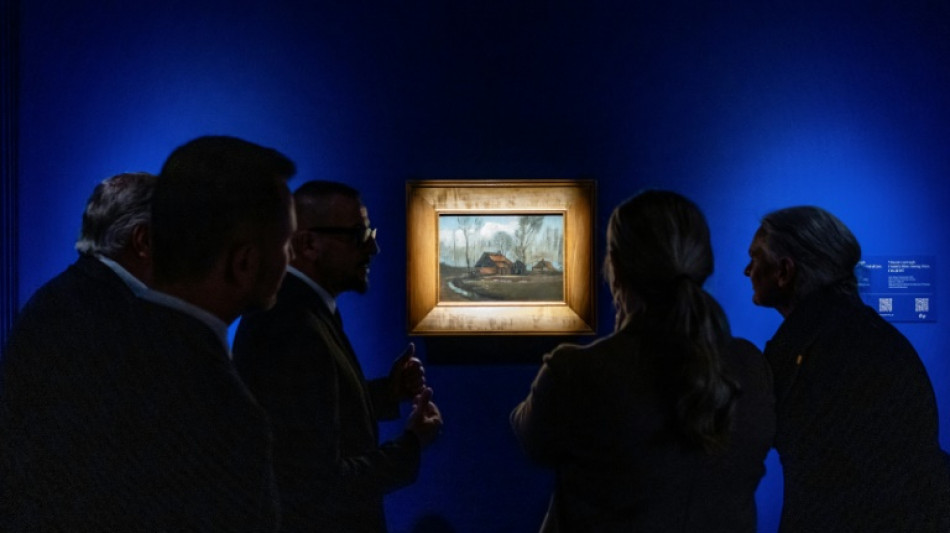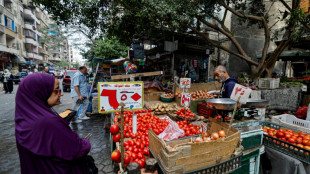
-
 Debt-saddled Laos struggles to tame rampant inflation
Debt-saddled Laos struggles to tame rampant inflation
-
India's vinyl revival finds its groove

-
 Climate finance can be hard sell, says aide to banks and PMs
Climate finance can be hard sell, says aide to banks and PMs
-
Egypt's middle class cuts costs as IMF-backed reforms take hold

-
 Dinosaur skeleton fetches 6 million euros in Paris sale
Dinosaur skeleton fetches 6 million euros in Paris sale
-
Trump's Republican allies tread lightly on Paris pact at COP29

-
 China's Xi urges APEC unity in face of 'protectionism'
China's Xi urges APEC unity in face of 'protectionism'
-
Farmers target PM Starmer in protest against new UK tax rules

-
 UN climate chief urges G20 to spur tense COP29 negotiations
UN climate chief urges G20 to spur tense COP29 negotiations
-
Philippines warns of 'potentially catastrophic' Super Typhoon Man-yi

-
 Tens of thousands flee as Super Typhoon Man-yi nears Philippines
Tens of thousands flee as Super Typhoon Man-yi nears Philippines
-
Gabon votes on new constitution hailed by junta as 'turning point'

-
 Tens of thousands flee as Typhoon Man-yi nears Philippines
Tens of thousands flee as Typhoon Man-yi nears Philippines
-
Is Argentina's Milei on brink of leaving Paris climate accord?

-
 Fitch upgrades Argentina debt rating amid economic pain
Fitch upgrades Argentina debt rating amid economic pain
-
Trump picks Doug Burgum as energy czar in new administration

-
 At summit under Trump shadow, Xi and Biden signal turbulence ahead
At summit under Trump shadow, Xi and Biden signal turbulence ahead
-
Xi warns against 'protectionism' at APEC summit under Trump cloud

-
 Xi, Biden at Asia-Pacific summit under Trump trade war cloud
Xi, Biden at Asia-Pacific summit under Trump trade war cloud
-
Leftist voices seek to be heard at Rio's G20 summit

-
 Boeing strike will hurt Ethiopian Airlines growth: CEO
Boeing strike will hurt Ethiopian Airlines growth: CEO
-
US retail sales lose steam in October after hurricanes

-
 Spate of child poisoning deaths sparks S.Africa xenophobia
Spate of child poisoning deaths sparks S.Africa xenophobia
-
Comedian Conan O'Brien to host Oscars

-
 Gore says 'absurd' to hold UN climate talks in petrostates
Gore says 'absurd' to hold UN climate talks in petrostates
-
Global stocks struggle after Fed signals slower rate cuts

-
 China tests building Moon base with lunar soil bricks
China tests building Moon base with lunar soil bricks
-
Oil execs work COP29 as NGOs slam lobbyist presence

-
 Gore says climate progress 'won't slow much' because of Trump
Gore says climate progress 'won't slow much' because of Trump
-
'Megaquake' warning hits Japan's growth

-
 Stiff business: Berlin startup will freeze your corpse for monthly fee
Stiff business: Berlin startup will freeze your corpse for monthly fee
-
Dominican Juan Luis Guerra triumphs at 25th annual Latin Grammys

-
 Tropical Storm Sara pounds Honduras with heavy rain
Tropical Storm Sara pounds Honduras with heavy rain
-
TikTok makes AI driven ad tool available globally

-
 Japan growth slows as new PM readies stimulus
Japan growth slows as new PM readies stimulus
-
China retail sales pick up speed, beat forecasts in October

-
 Pakistan's policies hazy as it fights smog
Pakistan's policies hazy as it fights smog
-
Mexico City youth grapple with growing housing crisis

-
 Cracks deepen in Canada's pro-immigration 'consensus'
Cracks deepen in Canada's pro-immigration 'consensus'
-
Japan's Princess Mikasa, great aunt to emperor, dies aged 101

-
 Venezuela opposition activist dies in custody
Venezuela opposition activist dies in custody
-
Policymakers defend Fed independence amid concerns about Trump era

-
 Lebanon economic losses top $5 billion in year of clashes: World Bank
Lebanon economic losses top $5 billion in year of clashes: World Bank
-
Fed Chair calls US the best-performing major economy in the world

-
 Brother of late Harrods owner also accused of sexual violence: BBC
Brother of late Harrods owner also accused of sexual violence: BBC
-
New York to revive driver congestion charge plan, drawing Trump ire

-
 China's Xi arrives in Peru for APEC summit, Biden meeting
China's Xi arrives in Peru for APEC summit, Biden meeting
-
Spain's Vanguardia daily to stop posting on 'disinformation network' X

-
 New York to revive driver congestion charge plan
New York to revive driver congestion charge plan
-
US stocks wobble as traders weigh future Fed cuts


Poland trumpets its Van Gogh, once peddled for a beer
Poland opened an art show Friday to celebrate its only Van Gogh painting, a rare early landscape worth millions that was once hawked by a pedlar for the price of a beer.
"Country Huts Among Trees" dates from 1883 when the impoverished Dutch artist was still learning to paint in the countryside around The Hague.
The small oil painting -- also known as "Farmhouses Among Trees" -- is "interesting for its modesty and for showing a whole different side to Van Gogh," said Agata Smolnicka, co-curator of the Warsaw show.
"He painted it with a limited palette, and not many who are acquainted with his 'Starry Night' French period know about his Dutch phase," she told AFP.
"The works from The Hague are relatively scarce," said Teio Meedendorp, of Amsterdam's Van Gogh Museum, which authenticated the unsigned canvas.
"He painted about 75 pictures there but only 30 survived. The rest were simply destroyed or lost over the years," he told AFP.
- 'Junk' -
The canvas ended up in a carpenter's attic with a pile of Van Gogh's other early paintings when he moved abroad.
The carpenter eventually sold "that junk" -- as he called them -- for a song to a hawker who peddled the pictures from his handcart.
"He brought the works to a cafe... Anyone who bought him a round of beer received a Van Gogh," exhibition consultant Juliette van Uhm wrote in the show's catalogue.
"Some canvases were given to children to play with; they tied them around their waists as if they were aprons," she added.
Many were saved by a discerning tailor who tried to buy them all up. They were later exhibited and sold, with the Polish Van Gogh ending up in Switzerland.
Charles Zbigniew Carroll-Porczynski, a Polish collector in Britain, bought the painting in 1987 and donated it to the Catholic Church in his homeland.
The new show at Warsaw's Museum of John Paul II and Primate Wyszynski explores various facets of the canvas.
- 'Born colourist' -
Co-curator Stefania Ambroziak said the painting was "Van Gogh before Van Gogh". She said he was "getting acquainted with oil paint and learning how to apply colour".
By this point, Van Gogh had already worked very hard at his drawing -- with experts saying he was no prodigy like Picasso or Toulouse-Lautrec.
"When you see juvenile work by Vincent, it's a big surprise he became an artist," Meedendorp said, laughing.
"Because he was not very good. I mean he had no natural feel for perspective and proportion."
What he did have was speed, which is evident in the painting on show in Warsaw.
"You can distinguish the hand of a very quick painter, working wet-in-wet very quickly. And this is a wonderful example of it," Meedendrop said.
Although the palette of the Polish painting is darker than the dazzling hues commonly associated with Van Gogh, Meedendorp said it testifies to his innate gift for colour.
"He was very good at mixing his colours, and opposing colours, with the reddish and green," Meedendorp said.
"He was a born colourist, but it was only when he really learned about colour in Paris... that he developed into the great painter he became," he said.
"Van Gogh. The Stories of One Painting" runs in Warsaw until December.
P.Schmidt--CPN
